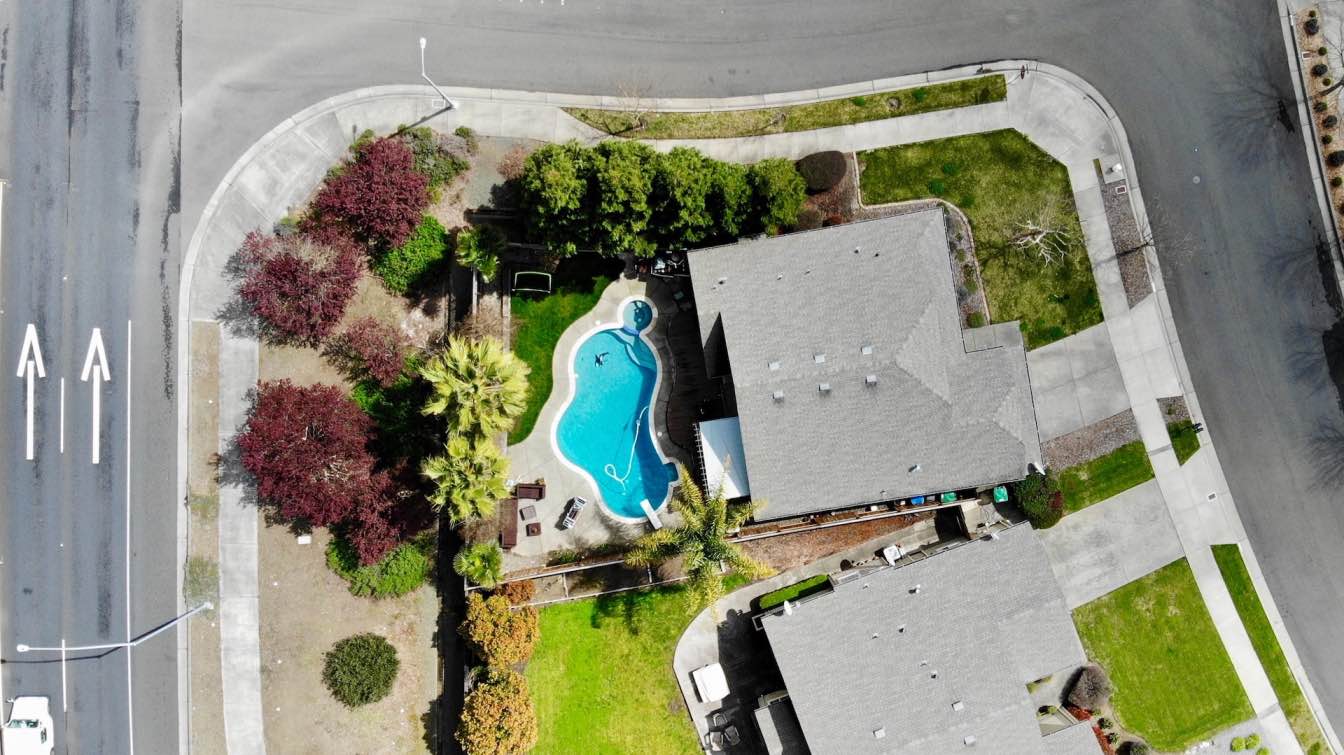Your roof is more than just the top of your house. It's your home's first line of defense against the elements, keeping you safe and dry. Understanding your roof, its materials, and when it needs attention is crucial for every homeowner. In this guide, we'll explore everything you need to know about residential roofing, from different styles and materials to maintenance and replacement.
Understanding Key Residential Roof Styles
Roof silhouettes dictating peak shapes impart homes with architectural character visible from afar. Beyond aesthetics solely, configurations also influence shed drainage trajectories, avoiding leak risks. Familiarize yourself with some classic roof designs:
Gable Roofs
This double-sloping peaked silhouette featuring triangular wall ends proves ubiquitous thanks to simple truss framing and drainage effectiveness shedding water and snow quickly on both sides.
Hip Roofs
With sloped sides meeting at center ridges equally inclined inward, hip roofs prevail on rectangular homes, allowing complete water runoff while handling high wind pressures through enhanced aerodynamic shaping.
Flat Roofs
Maintaining slight inclines still allowing rainfall redirection, flat roofing creates contemporary streamlined appearances and additional usable square footage as rooftop patios/decks when appropriately waterproofed and reinforced below.
Gambrel Roofs
Similar to barns, dual-pitched gambrel roofs follow steeply inclined shallow slopes maximizing interior volume like attics inside the silhouette using a top roofline nesting within main lower slopes underneath.
Mansard Roofs
Featuring double slopes on all four sides with lower-pitched upper levels joined to steeper lower sections along eaves, mansard roofs add climate-appropriate attic space, providing insulation buffers against extreme cold/heat while allowing additional rooms.
A World of Roofing Materials
Beyond shapes keeping the great outdoors outside, materials create defensive moisture barriers doing the heavy lifting and protecting homes:
Asphalt Shingles
Ubiquitous asphalt shingle roofs reign supreme across North American suburban homes thanks to their affordability and decades of proven water shedding and might handle harsh weathering well with proper underlayment reinforcements securing them in place.
Metal Roofs
Lightweight sheet metal roofing made from steel or aluminum promises heightened longevity thanks to rust/rot proofing. Elements like rain or hail glance right off them and easily shed instead of damaging upon impact year after year.
Concrete Tiles
Prevalent along coastal regions and historic Mediterranean abodes, concrete tile roofs made from sand/cement composite mixtures withstand hurricane-force winds and enjoy vast lifespan longevity, keeping homes covered.
Slate Roofs
Beautifully traditional natural slate rock roofing sourced from quarries offers incredible durability, fire/rot resistance, and ultra-low water absorption, making them ideal for regions facing heavy snow accumulation, reliably guarding homes winter after winter once installed properly on adequately braced rafters.
Wood Shakes/Shingles
Western red cedar wooden roof coverings treated with fire/insect repellents inject rustic architectural charm. But maintenance needs and flammability considerations in drier climates make monitoring their conditions routinely imperative for sustained performance.
Knowing When Your Roof Needs Attention
Even durable roofing eventually ages out, succumbing to erosion and elemental exposures, indicating replacement time. Detect issues early through:
Observing External Damage Signs
After extreme weather, seek lifted shingles, ruptured metal seams or cracks, plus algae film buildup annually, hastening deterioration. Don’t delay repairs once spotted.
Pinpointing Leaks
If inside ceilings or attic spaces reveal water stains, identify breaches outside immediately before the underlying wood infrastructure rots, causing even costlier structural repairs down the line.
Noting Granule Loss
Look for piles of sand-like granules washing away routinely, which help seal shingles once lost, quickening exposure deterioration without barrier protection, causing amplified sun damage and reduced weatherproofing shields long term.
Removing Moss Carefully
While picturesque superficially, thick moss beds trapping moisture below accelerate decay, shortening lifespans drastically. So, surgically eradicating growth helps avert escalation without damaging surrounding roof areas with overzealous scraping attempts.
Tracking Energy Spikes
Drafty attics, icicle build-ups, and raised winter/summer AC costs signal poor insulating values from aging shingle fabrics, indicating replacement needs aligning with Green Energy codes, maximizing household efficiencies, and minimizing waste.
The Roofing Process Simplified
Once recognize your home’s protective layer needs servicing soon, navigating ideal solutions requires:
Inspections Assessing Conditions
Hire reputable local roofing contractors thoroughly evaluating the damage, leaks, rot, and material integrity, quantifying remaining viable lifespans, ecological footprint and insulation ratings toward advising repair feasibility versus full replacement budgeting.
Repairs vs. Complete Overhauls
If issues stay isolated or newer materials remain well-conditioned overall, simple fixes solve singular problem zones cost-effectively, extending years left, avoiding unnecessary wholesale changeovers best reserved once aging encompasses over 20% across the entire surface.
Material Reselection
When the time arrives for total replacements, reassess the latest thermal efficiency codes, extreme weather frequency upticks, environmental goals, and modern material advancements to determine if alternatives like recycled composites or solar shingles suit evolving needs better aligned to refreshed sustainability outlooks.
Streamlining Installation
Established local roofers understand navigating permitting, zoning specifications, and safe installation intricacies essential for quality craftsmanship upholding watertight performance metrics for decades protecting your most valuable asset and shelter – home sweet home!
Roofing: Unique Considerations
Cape Cod's coastal location and unique climate present specific challenges for homeowners and roofing professionals alike. If you're maintaining or replacing a roof in this picturesque area, there are several factors you need to consider to ensure your roof can withstand the local conditions and protect your home effectively.
Salt Corrosion
The salty sea air that gives Cape Cod its refreshing atmosphere can be tough on roofing materials. Salt can accelerate corrosion, especially on metal components of your roof. Here's what you need to know:
- Metal roofing materials, flashings, and fasteners need to be corrosion-resistant.
- Regular cleaning and maintenance are crucial to prevent salt buildup.
- Consider using specially coated materials designed for coastal environments.
Wind Damage
Cape Cod is known for its strong coastal winds, which can wreak havoc on roofs. Hurricanes and nor'easters are not uncommon, making wind resistance a top priority:
- Choose roofing materials rated for high wind resistance.
- Ensure proper installation techniques are used, such as additional fasteners and adhesives.
- Regular inspections are essential, especially after major storms.
- Consider impact-resistant materials to protect against wind-blown debris.
Snow Load
While Cape Cod doesn't typically see as much snow as inland areas of Massachusetts, winter storms can still dump significant amounts of heavy, wet snow on roofs:
- Ensure your roof structure can handle potential snow loads.
- Proper insulation and ventilation can help prevent ice dams.
- Consider a roof design that sheds snow easily, like a steeper pitch.
- Be prepared for snow removal if accumulation becomes excessive.
Local Roofing Contractors
Working with a local roofing contractor who understands Cape Cod's unique environmental challenges is crucial. Roofing in Cape Cod, MA, requires specific expertise:
- Local contractors will be familiar with regional building codes and regulations.
- They'll have experience dealing with the area's specific climate challenges.
- Local professionals can recommend the best materials and techniques for Cape Cod homes.
- They will likely have established relationships with local suppliers, potentially saving you money.
By taking these unique considerations into account, you can ensure that your Cape Cod home's roof is well-equipped to handle the local climate and protect your home for years to come. Remember, investing in quality materials and professional installation tailored to Cape Cod's specific needs can save you money and headaches in the long run.
Conclusion
Your roof is a crucial component of your home, providing protection, energy efficiency, and curb appeal. Understanding the different styles, materials, and maintenance needs of your roof can help you make informed decisions about repairs or replacements when the time comes.
Remember, regular inspections and prompt attention to any issues can extend the life of your roof and prevent costly damage to your home. Whether you're dealing with a minor repair or a full replacement, always work with reputable, experienced roofing professionals to ensure the job is done right.
By taking good care of your roof, you're not just maintaining a part of your house – you're protecting your home and everything in it. Your roof truly is your home's guardian, standing strong against sun, wind, and rain to keep you safe and comfortable year after year.





